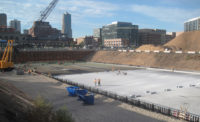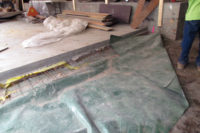The risk of water leakage through below-grade waterproofing systems is an unfortunate reality of foundation construction. Today, owners, designers, builders, and manufacturers are challenged by the design of buildings with deep foundations in demanding groundwater conditions, considering the intent to construct high-performing and dry structures. These intentions are balanced with the reality that perfection in the installation of waterproofing is unrealistic and some potential for leakage typically remains, particularly in conditions exposed to hydrostatic groundwater pressure.
Designers and owners are becoming more aware of the performance and workmanship limitations associated with below-grade waterproofing systems. Despite this understanding, there is a common misperception that any leakage remediation is covered as part of the manufacturer’s warranty. Over the years, manufacturers have been responding to this misperception, and the market’s desire for more comprehensive warranty coverage, by developing warranty options that can better align with project-specific expectations and liability management.
This paper discusses how warranties can affect projects, reviews typical warranty options and considerations, and outlines how warranties can be used to enhance project-appropriate performance and accountability.
The Misperception
Water leakage through foundations is typically related to breaches in the below-grade waterproofing system that are exposed to hydrostatic pressure, from elevated groundwater or lack of drainage outboard of the foundation. The breaches can be caused by a number of factors, including improper installation, trade damage after installation, building movements, material limitations and deterioration, or design-related issues.
The design of continuous below-grade waterproofing systems is often challenged by foundation elements, support of excavation, underpinning, and concrete forming systems, all of which may not consider waterproofing performance as a primary driver to their design. Further, the installation of below-grade waterproofing systems is often compromised by the site conditions, including wet and soiled environments, fast-track schedules, insufficient coordination between trades, and the need for a nuanced understanding of the various waterproofing system properties. Repairing the below-grade waterproofing on existing buildings can be complicated, costly, and disruptive because, in most cases, membrane breaches cannot be exposed for repair.
Once leakage is identified, the owner will often contact the waterproofing installer and manufacturer to repair the leakage of the warranted assembly. All too often, the warranty agreement excludes the labor associated with addressing the leakage and may only provide the materials necessary to make repairs. The potential value of replacement waterproofing provided at no cost is typically offset by the much higher cost for permitting, access, excavation, loss of operation or disruption, and labor to repair the waterproofing installation. As a result, negative-side repairs (from the interior of the building) are often used to address the leakage and the owner is accountable for the cost because it is not part of the warranty coverage.
Warranty Options
A warranty is a written agreement promising a defined set of material and/or labor coverage for the below-grade waterproofing installation if it is proven to be defective. The performance characteristics that can trigger a warranty claims vary, often depending upon nuanced definitions of “leakage”. The responses of the at-risk party in the warranty agreement can also vary, from expedient repairs of readily apparent leakage to a detailed investigation and laboratory testing. The later approach is sometimes taken to determine whether the materials comply with their intended physical properties, to allocate responsibility for the cost of repairs.
Some of the most common below-grade waterproofing warranty options include the following:
- Materials Only – This is a limited warranty that covers replacement of defective materials as a result of a material or manufacturing issue that caused leakage. This type of warranty does not cover costs for labor, access, or loss of operation. In most cases, there is no additional charge for this warranty.
- Performance-based, with No Dollar Limit (NDL) and Limited Coverage Options – This warranty provides repair or replacement of materials as required to address the leakage. NDL includes all necessary costs required to fully address the leakage, whereas “limited” provides coverage up to a specific dollar amount, typically the overall material cost of the initial waterproofing installation. This type of warranty can require an incremental cost, manufacturer involvement during specific design and construction milestones, and additional construction phase work, including meetings, third-party inspections, and collaboration with the manufacturer. These costs can be substantial, are typically borne by the owner, and should be considered prior to construction.
- Contractor Warranty – This warranty has a specific correction period, typically between one and five years, when the contractor has the obligation to repair their work if it fails to perform. If the work is found to be deficient beyond this period, the owner will have to rely on any remaining warranty from the manufacturer.
- Implied Warranty – This includes warranties of merchantability and fitness, which state that a product is suitable for a particular purpose or application, and that it assumes certain “common sense” conditions regarding quality and performance. These types of warranties are often an explicit exclusion in manufacturer’s warranty language and should be mitigated through project-specific requirements, which are generally written into the specifications. These requirements may include review and written approval of the design and installation by the warranty holder(s).
Considerations
Effective warranties help to define the expectations between the owner, designer, builder, and manufacturer. The valuable intent to clarify responsibilities in the form of a written agreement can, at times, seemingly complicate the roles of involved parties due to the various scenarios to be considered. Some of the considerations include the following:
- Manufacturer Validation and Ownership Approval: Some performance-based warranties require that the manufacturer review the design documents to validate intent to provide the specified warranty. Although this can add time to the schedule, it can provide additional coverage in the absence of implied warranties, as described above.
- Construction Schedule: The additional effort and resources required to obtain a performance-based, NDL warranty for below-grade waterproofing will have an impact on schedule and budget, and must be weighed against the owner’s desire to have comprehensive coverage against leakage.
- Triggers that Void Warranties: Various issues can void warranties, including change in building ownership, repairs performed by contractors that are not approved, use of materials or methods that are not approved, and lack of notification to the manufacturer prior to making repairs and within the specified time limit.
- Collateral Damage: Labor and materials to repair interior finishes and other building systems, and costs associated with schedule impact or building operations, are not typically included as part of waterproofing warranties.
- Repair Methodology: Most warranty repairs are performance-based and the materials and methods used to make the repairs are often directed by the at-risk party and installed based on their availability to complete the work. This can result in the use of materials and systems that are inferior to those specified for the project, and installation within a schedule that may differ from the Owner’s expectations.
Success with Warranties
To avoid the “misperception”, warranties must have clear definition for what the warranty includes and define the triggering event. Ambiguities in the warranty language, and lack of full understanding of the language by the project team, are the main reasons why warranties can create a false sense of security.
Warranties do not replace the need for complete contract documents and proper installation that facilitate the owner’s project requirements. A foundation leak that is fully-covered by a comprehensive warranty is not a substitute for a foundation that does not leak.
From a manufacturer’s standpoint, the more useful warranties are business agreements that can provide an agreed-upon quality assurance program for the design and construction that will hold the manufacturer liable only if the product fails to perform when it is used as specifically intended. This can be a proactive way for the manufacturer to limit their exposure to the cost of repairs while also actively engaging with the project team to affect a positive outcome for the project.
From an ownership perspective, warranties establish an agreed-upon standard for the installation based on the owner’s project requirements and desired level of coverage. Following the completion of construction, the warranty provides the owner with a means to hold the manufacturer and/or installer accountable for their work should there be foundation leakage.
Similarly, from a design perspective, warranties should be viewed as an organized system to communicate an acceptable standard of construction. The functional goal of a warranty, as it pertains to the design process, is to establish a set of expectations that reinforces the design intent. In this capacity, a warranty can help to protect against unequal substitutions, sub-standard detailing, and variations in workmanship. Conversely, a warranty is not a substitute for sound design based on experience and engineering principles.
From a contractor’s standpoint, a comprehensive warranty program provides clear parameters for the project-specific installation requirements and engages the manufacturer to provide input throughout construction. Particularly in cases where the installer carries liability, it benefits the contractor to establish clear design intent, owner’s expectations, and warranty triggers prior to construction.
Warranties can open the lines of communication among the project team, if properly implemented, and this can benefit all members of the project team. That said, warranties should be viewed as an owner-manufacturer business agreement whose terms should be negotiated; not as a standalone QA/QC program, or a substitute for quality, project-specific design.
Summary
Warranties for below-grade waterproofing systems help to define the expectations among the members of the project team, and can improve the standard of the design and construction. Owners, designers, builders, and manufacturers are gaining a better understanding of the performance expectations with below-grade waterproofing systems, and manufacturers continue to revise their warranty options to better align project-specific expectations and manage their liability.
If employed thoughtfully, and in tandem with adequate construction documents and competent construction phase services, warranties can be a very effective tool to assist with meeting the owner’s project requirements. Project teams must also recognize the limitations of warranties, which are ultimately business agreements that should enhance project requirements, to avoid the common misperception.








